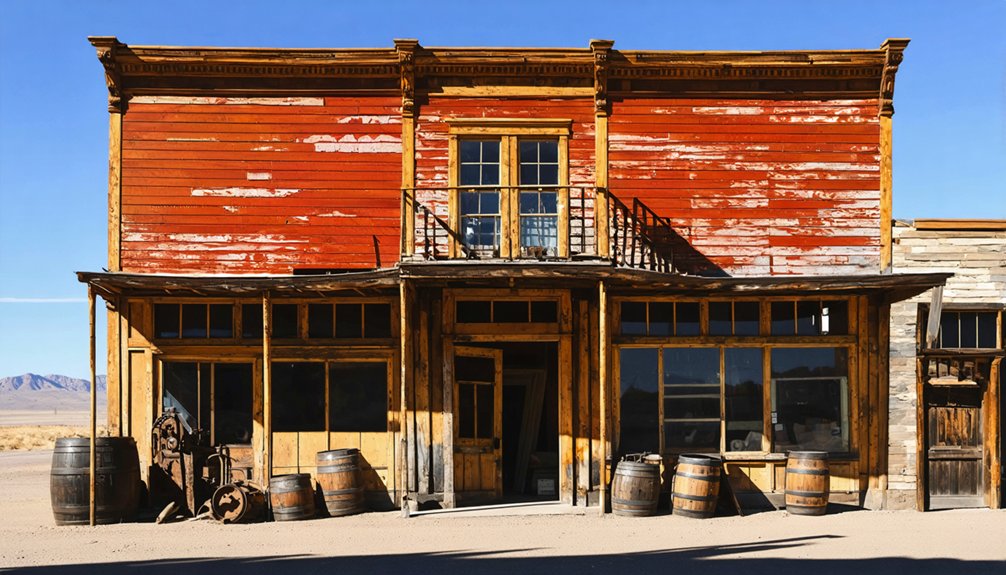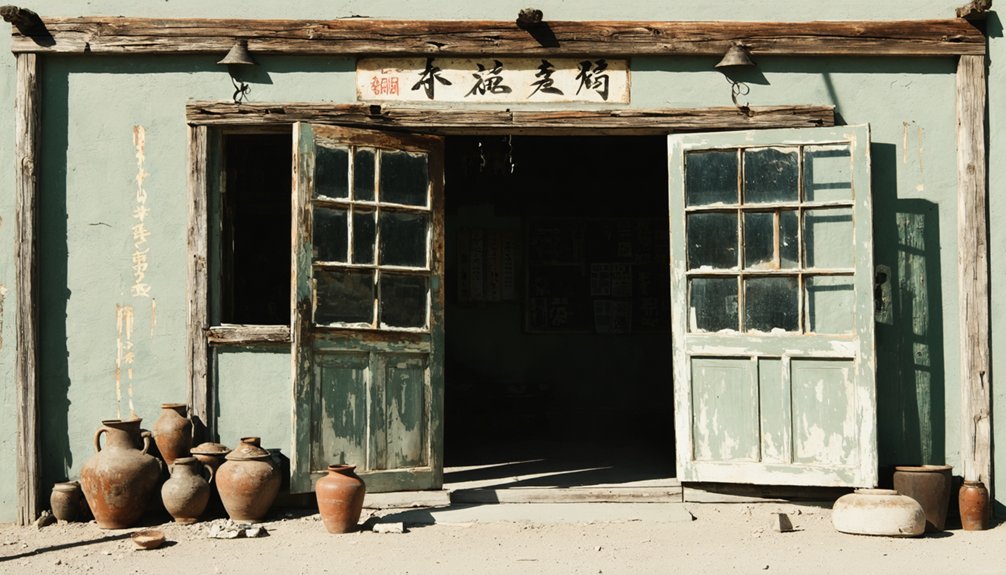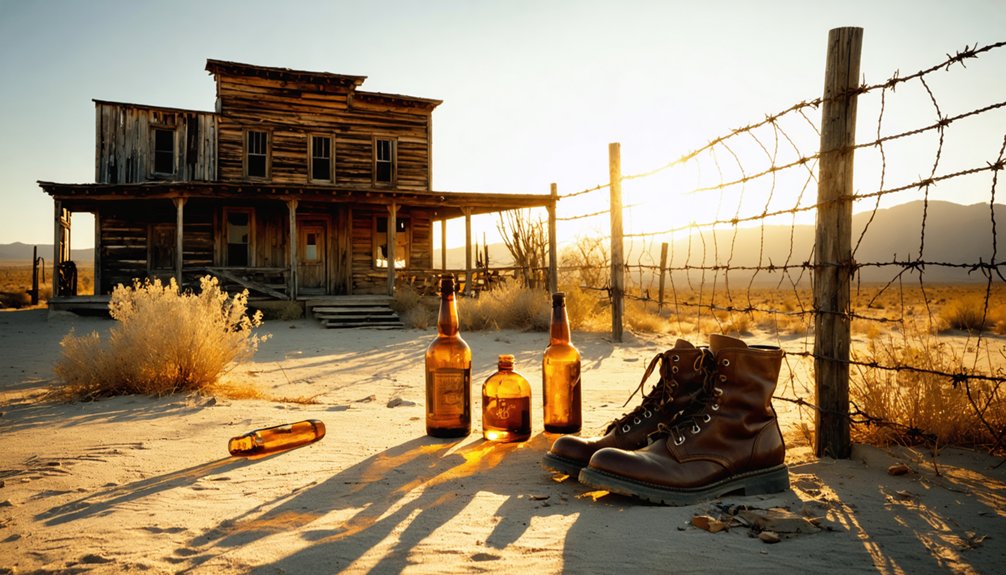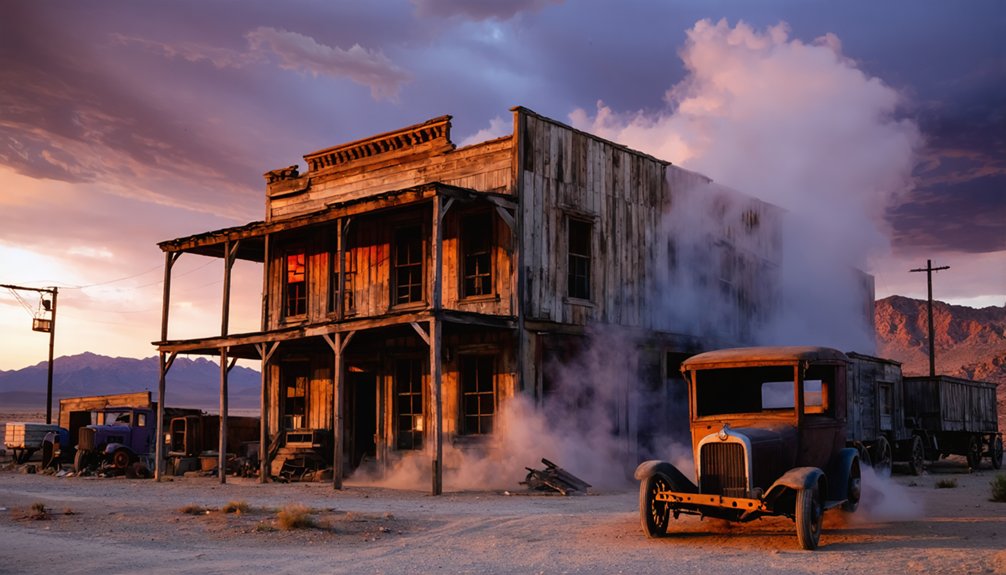You’ll discover Nevada’s most fascinating abandoned mining towns in sites like Rhyolite, with its iconic bank building, and Goldfield’s impressive stone architecture featuring original Tiffany lamps. Don’t miss Pioche’s Wild West legacy at Boot Hill Cemetery, or Nelson’s historic Techatticup Mine tours. From Delamar’s “Widowmaker” ruins to Gold Point’s preserved structures, these ghost towns showcase the state’s rich mining heritage through authentic buildings, artifacts, and compelling stories of boom-and-bust cycles.
Key Takeaways
- Rhyolite Ghost Town offers impressive ruins including the iconic John S. Cook Bank Building and remains Nevada’s most photographed abandoned mining site.
- Goldfield features well-preserved stone buildings from 1907-1908, including the grand Goldfield Hotel and Esmeralda County Courthouse with original Tiffany lamps.
- Pioche’s Boot Hill Cemetery and Million Dollar Courthouse tell stories of the Wild West, with numerous preserved buildings from its silver mining heyday.
- Nelson’s Techatticup Mine provides guided tours through hand-dug tunnels, showcasing original quartz veins and $10 million in historical precious metals production.
- Gold Point maintains approximately 50 historic structures, representing Nevada’s mining legacy through multiple boom periods of silver and gold discovery.
The Historical Grandeur of Rhyolite Ghost Town
Rhyolite stands as one of Nevada’s most remarkable ghost towns, emerging from a fortuitous gold discovery in the Bullfrog Hills by prospectors Frank “Shorty” Harris and Ernest “Ed” Cross in 1904.
The town’s meteoric rise saw it become Nevada’s largest settlement, with up to 8,000 residents by 1908. The bustling community featured fifty different saloons, catering to the thirsty miners and townspeople. During the mining boom, you’d have found a sophisticated urban center boasting hospitals, banks, churches, and an opera house – amenities rarely seen in mining camps of that era.
Today, Rhyolite’s ruins tell a story of both ambition and impermanence. The iconic John S. Cook Bank Building, completed in 1908, remains the most photographed ghost town structure in the West. The town’s forward-thinking infrastructure included electrical lines that powered the streets and buildings until 1916.
While the mines went bust by 1911, the Bureau of Land Management now preserves these historic structures in “arrested decay,” offering you a glimpse into Nevada’s golden age.
Nelson’s Mining Legacy and El Dorado Mine Tours
A tribute to Nevada’s rugged mining history, Nelson emerged from Spanish explorations in 1775 as El Dorado, later becoming one of the state’s most notorious and productive mining districts.
The Southern Paiute tribe originally inhabited and mined the area long before European settlers arrived.
The town’s notorious reputation grew from its violent labor disputes, which often ended in bloodshed.
You’ll discover Nelson’s history through its centerpiece, the legendary Techatticup Mine, which yielded $10 million in precious metals between the 1860s and 1900.
Today, you can explore El Dorado’s significance firsthand through guided tours of the hand-dug tunnels, where you’ll witness the original quartz veins that once held the region’s gold.
As you venture through the cool, breezy passages, you’ll learn about the town’s turbulent past, marked by claim disputes and lawlessness.
The preserved ruins, vintage vehicles, and historic structures offer an authentic glimpse into Nevada’s mining heritage.
Pioche: Where the Wild West Still Lives
When you visit Pioche today, you’ll find yourself stepping into an authentic slice of the Wild West, where historic structures like the Overland Hotel and Saloon still stand as monuments to its notorious mining-town legacy.
You can explore remnants of the town’s turbulent past, including Boot Hill Cemetery, where violent deaths from the 1870s boom era are memorialized.
The town’s wild reputation is evident in the fact that sixty percent of Nevada’s homicides in 1871-72 occurred in Pioche alone.
While the population has dwindled notably from its peak of 7,000 residents, Pioche retains its frontier character through preserved buildings and mining artifacts that tell the story of Nevada’s silver rush era.
The historic Million Dollar Courthouse, built in 1871, remains a testament to the town’s once-booming prosperity.
Historic Buildings Still Standing
Standing as monuments to Nevada’s rugged mining era, Pioche’s historic buildings offer visitors a remarkably preserved glimpse into the American frontier‘s tumultuous past.
Despite devastating fires and economic upheavals, these architectural treasures continue to tell stories of wealth, lawlessness, and determination through their weathered walls and rustic designs.
The town’s boom during the 1870s led to the creation of a Pioche & Bullionville Railroad that connected key mining operations.
You’ll discover these enduring landmarks throughout town:
- The Million Dollar Courthouse, an imposing symbol of frontier justice and mining wealth
- The still-operational Overland Hotel and Saloon, renowned for its historic ambiance and paranormal activity
- The Silver Cafe, a surviving social hub from the early 1900s
- Scattered miners’ rock houses from the 1870s, offering authentic insights into frontier life
These structures represent the epitome of historic preservation, showcasing simple yet sturdy architectural styles that have withstood the test of time.
Wild Mining Town Legacy
While these historic buildings stand as silent witnesses, Pioche’s true legacy lies in its notoriously wild past as one of Nevada’s most dangerous mining towns.
You’ll find the echoes of its lawlessness legacy in Boot Hill Cemetery, where Murderers’ Row tells the grim tale of a town that once accounted for 60% of Nevada’s reported killings.
Mining rivalries between powerhouse companies like Raymond & Ely and Meadow Valley fueled much of the violence, as intense competition for silver claims turned Pioche’s main street into a battleground.
In the 1870s, with a population of 10,000, you’d have witnessed a raw frontier town where gunfights and legal battles shaped daily life.
Today, the abandoned mines and weathered headframes serve as stark reminders of this unvarnished chapter in Nevada’s Wild West history.
Modern-Day Ghost Life
Though Pioche’s lawless heyday has long passed, this living ghost town continues to captivate visitors with its authentic Wild West atmosphere and paranormal intrigue.
You’ll discover a remarkable blend of historic preservation and modern life as you explore this former silver mining powerhouse, where residents still call century-old buildings home.
For an immersive historical experience, you’ll want to check out:
- The haunted Overland Hotel, where five resident ghosts await paranormal enthusiasts
- Boot Hill Cemetery tours, showcasing the final resting place of 72 murder victims
- The historic Silver Cafe, serving visitors since 1907
- Ghost tours through original structures and mining remnants scattered across town
The town particularly comes alive during holiday events when museums open their doors, offering you intimate glimpses into Nevada’s rugged mining heritage.
Goldfield’s Preserved Architecture and Gold Rush History

When you visit Goldfield today, you’ll find impressive stone buildings from its 1907-1908 heyday, including the grand Goldfield Hotel and the still-functioning Esmeralda County Courthouse with its original Tiffany lamps.
You can explore the Nixon and Wingfield Block’s preserved architecture, which showcases the town’s immense wealth during its peak when Goldfield was Nevada’s largest city with 8,000 residents and 250 mining companies.
The town’s surviving structures and mining equipment serve as evidence to the engineering achievements of Nevada’s gold rush era, having withstood both the devastating 1923 fire that destroyed 53 city blocks and a century of desert conditions.
Located at an elevation of 5,689 feet, Goldfield’s high desert setting has helped preserve many of its historic structures despite harsh environmental conditions.
The hotel, built by banking tycoon George Wingfield, featured 150 luxurious rooms with private baths, crystal chandeliers, and mahogany furnishings throughout its elegant lobby.
Historic Buildings Still Standing
The historic Goldfield District stands as one of Nevada’s most remarkable architectural time capsules, with approximately 120 buildings dating from 1904 to 1909 spread across thirty-five city blocks.
When you explore this abandoned architecture, you’ll discover a mining heritage preserved in Neo-Classical and Georgian Revival styles, reflecting the town’s brief but prosperous golden age.
Among the most significant structures still standing:
- The four-story Goldfield Hotel, featuring impressive grey granite facades and Classical Revival design
- The Nixon and Wingfield Block, a three-story stone edifice built by prominent Nevada businessmen
- The Goldfield Consolidated Mines Building, showcasing the town’s commercial prosperity
- The Curtis/Ish Building and John S Cook & Co Bank, prime examples of boom-era financial institutions
These surviving structures tell the story of Goldfield’s meteoric rise as Nevada’s largest city during the early 1900s. A devastating fire in 1923 destroyed many original buildings across 53 blocks of central Goldfield, making the remaining structures even more historically significant.
Mining Equipment On Display
Mining enthusiasts and history buffs will discover an impressive collection of preserved Gold Rush-era equipment throughout Goldfield’s historic district.
You’ll find remarkable mining machinery displays at the Historic Equipment Park, featuring turn-of-the-century technology and WWII military equipment. The Florence Mine’s hoist house, the district’s only surviving example, showcases historical extraction techniques that once processed Nevada’s richest gold ore.
At the Central Nevada Museum, you can explore outdoor exhibits including a 10-stamp mill and ore cars that demonstrate the complete mining process.
The town’s extensive railroad infrastructure remnants reveal how five rail lines transported precious metals from Goldfield’s mines.
Don’t miss the salvage yards, where you’ll find fascinating collections of adapted mining tools and underground equipment that tell the story of innovation during Nevada’s mining heyday.
Delamar: The Infamous “Widowmaker” Mining Camp
Located in a remote Nevada valley, Delamar emerged from humble beginnings as Ferguson Camp in 1889 after prospectors John Ferguson and Joseph Sharp discovered gold in Monkeywrench Wash.
When Captain Joseph De Lamar purchased the mines in 1893, the camp transformed into one of Nevada’s richest gold producers, processing 260 tons of ore daily by 1896.
Despite Delamar’s cultural life featuring brass bands and opera house performances, the town earned its infamous nickname “The Widowmaker” due to deadly working conditions.
Behind Delamar’s refined cultural facade lurked deadly mine conditions that gave this boomtown its grim moniker: The Widowmaker.
You’ll find these sobering remnants of its past:
- Silica dust from dry ore processing claimed countless miners’ lives
- The town peaked at 3,000 residents before health hazards drove many away
- The mines yielded over $15 million in gold between 1892-1909
- Native rock buildings still stand as evidence of frontier determination
Jarbidge: The Last Gold Rush Frontier

If you’re driving into Jarbidge today, you’ll find a resilient community of 50-100 residents who’ve maintained their connection to this historic mining site that once bustled with up to 2,000 people during the 1911 peak.
Within the town’s limits, you can still explore original structures from the 1910 gold rush era, offering tangible links to Nevada’s mining heritage.
The town’s remote location, while challenging to access, has helped preserve its authentic character and numerous historical artifacts that tell the story of America’s last significant gold rush.
Mining Life Today
Today, Jarbidge stands as a tribute to Nevada’s gold rush legacy, though its mining heyday has long since passed.
Modern mining activities have dwindled to occasional prospecting by hobbyists, with the once-productive Jarbidge Gold Prospect now silent. Despite this shift, the community’s resilience shines through in its preservation of mining heritage.
When you visit this remote outpost, you’ll find:
- A close-knit population of fewer than 200 year-round residents
- Historic structures and abandoned mining infrastructure that tell tales of $10 million in gold production
- Unpaved roads that maintain the town’s authentic frontier character
- Protected lands within Humboldt National Forest that limit new development
You’ll discover a community that values its independence while carefully balancing preservation with the practical needs of modern life.
Hidden Historical Treasures
Jarbidge’s hidden historical treasures paint a vivid portrait of Nevada’s last major gold rush, sparked by David Bourne’s 1909 discovery that transformed this remote canyon into a bustling frontier settlement.
Today, you’ll find fascinating abandoned artifacts scattered throughout the area, from ore cars to pneumatic drill stands, telling the story of early 20th-century mining ingenuity.
Deep within unopened mine shafts lie century-old equipment, while above ground, surviving wooden structures stand as evidence to the town’s resilient spirit.
Mining legends and Shoshone tales of supernatural forces add mystique to this historic site, where prospectors once extracted $10 million in gold.
As you explore the remnants of this 6,200-foot elevation boomtown, you’re walking through one of the West’s final chapters of gold rush history.
Gold Point’s Silver and Gold Mining Heritage
The mining town of Gold Point began its storied history as Lime Point in 1868, when prospectors discovered valuable lime deposits in the area. This gold rush settlement transformed through multiple identities, reflecting Nevada’s rich mining legacy.
From humble lime deposits to mining riches, Gold Point’s evolution mirrors Nevada’s dynamic frontier spirit.
After early silver mining proved challenging, the town was renamed Hornsilver in 1908 following significant silver ore discoveries.
You’ll discover four distinct phases that shaped Gold Point’s evolution:
- Initial silver mining attempts that faced shipping and processing hurdles
- The 1908 boom period when Hornsilver grew to 225 buildings
- The 1927 gold discovery that led to the town’s final name change
- World War II’s impact, which ultimately led to the town’s decline
Today, Gold Point stands as a living ghost town, preserving roughly 50 historic structures that tell the tale of Nevada’s mining heritage.
Tuscarora: a Window Into Chinese Mining History

While many Nevada mining towns attracted diverse populations, Tuscarora’s Chinese community stands out as particularly significant, with over 1,000 Chinese residents at its peak outnumbering white settlers by 1870.
Their mining innovations included expanding placer operations at the Beard discovery site and developing complex water ditch systems to support mining activities.
Chinese contributions to Tuscarora’s economy were substantial, with production estimates ranging from $700,000 to $7 million in gold between 1869 and 1870.
You’ll find evidence of their enterprising spirit in how they purchased abandoned claims and successfully worked them alongside Shoshone and Euro-American miners.
Today, you can explore this rich heritage through the town’s historic cemetery, mining ruins, and cultural landmarks, though the once-bustling community of thousands has dwindled to around 120 residents.
Discovering Blair’s Remote Desert Ruins
Hidden among Nevada’s remote desert landscape, Blair’s ruins tell the fascinating story of a short-lived but ambitious mining venture established in 1906 by the Pittsburgh Silver Peak Gold Mining Company.
You’ll find this ghost town exploration destination just three miles north of Silver Peak, where abandoned structures whisper tales of Nevada’s largest stamp mill and a sophisticated aerial tramway system.
During your visit, you’ll discover:
- Remaining stone buildings and mill foundations that once processed over $6 million in gold ore
- Historic remnants of a 17½-mile railroad spur that connected Blair to the Tonopah & Goldfield Railroad
- Traces of the 14,000-foot aerial tramway that transported ore from the Mary Tunnel
- Remote desert terrain accessible via State Route 265, perfect for off-road adventures
Today, these weathered ruins stand as silent sentinels to Nevada’s rich mining heritage.
Candelaria’s Hidden Mining Treasures
Nestled amid Nevada’s vast desert landscape, Candelaria emerged as a tribute to the region’s rich silver heritage after Mexican and Spanish prospectors first discovered precious ore deposits in 1863.
You’ll find the remnants of what was once Esmeralda County’s largest settlement, where Candelaria’s economy flourished after European miners introduced advanced mining techniques in the 1870s. The Northern Belle mine, producing $15 million in silver, transformed this outpost into a bustling town of 1,500 residents by 1881.
While you can explore the stone foundations today, imagine the town at its peak – complete with two hotels, dozens of saloons, and the Carson & Colorado Railroad connecting it to civilization.
Though mining resumed briefly in the 20th century, Candelaria’s glory days ended with the financial panic of 1893.
Frequently Asked Questions
What Safety Equipment Should I Bring When Exploring Nevada Ghost Towns?
Pack safety gear including sturdy boots, hard hat, gloves, eye protection, first aid kit, GPS, flashlights, and emergency radio. Don’t forget water and high-energy snacks for your exploration.
Are There Any Restrictions on Collecting Artifacts From Abandoned Mining Sites?
You’d think old mining trash was fair game, but artifact preservation laws strictly prohibit collecting anything historical. It’s illegal on public and private lands without proper permits – hefty fines await violators.
Which Ghost Towns Are Most Accessible During Winter Months?
You’ll find best winter accessibility at Osceola near Ely, where maintained county roads often remain passable. Lower-elevation ghost towns near highways and population centers offer more reliable winter conditions for exploration.
What’s the Best Time of Year to Photograph These Mining Towns?
Like a photographer’s dream, you’ll find your best shots during spring (March-May) and fall (September-November), when you’ll get ideal seasonal lighting, mild temperatures, and clear skies for exploring these historic structures.
Can You Camp Overnight in or Near These Abandoned Towns?
You can camp near ghost towns following camping regulations, either through dispersed camping on public lands or at nearby campgrounds, but you’ll need to stay 14 days maximum per location.
References
- https://www.legendsofamerica.com/nv-ghosttowns/
- https://www.youtube.com/watch?v=Dgv9wgQIblo
- https://www.reviewjournal.com/local/local-nevada/abandoned-but-not-forgotten-5-ghost-towns-in-southern-nevada-3351038/
- https://www.youtube.com/watch?v=iGs6SCw-oQU
- https://www.visittheusa.com/experience/6-nevada-ghost-towns-explore-if-you-dare
- https://www.youtube.com/watch?v=lXyHDThvoLU
- https://travelnevada.com/ghost-town/
- https://www.youtube.com/watch?v=xPLVDanhd3I
- https://nvtami.com
- https://forgottennevada.org/sites/newlist.html



